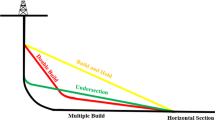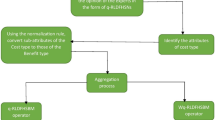Abstract
In this study, a fuzzy-Markov-chain-based stochastic dynamic programming (FM-SDP) method is developed for tackling uncertainties expressed as fuzzy sets and distributions with fuzzy probability (DFPs) in reservoir operation. The concept of DFPs used in Markov chain is presented as an extended form for expressing uncertainties including both stochastic and fuzzy characteristics. A fuzzy dominance index analysis approach is proposed for solving multiple fuzzy sets and DPFs in the proposed FM-SDP model. Solutions under a set of α-cut levels and fuzzy dominance indices can be generated by solving a series of deterministic submodels. The developed method is applied to a case study of a reservoir operation system. Solutions from FM-SDP provide a range of desired water-release policies under various system conditions for reservoir operation decision makers, reflecting dynamic and dual uncertain features of water availability simultaneously. The results indicate that the FM-SDP method could be applicable to practical problems for decision makers to obtain insight regarding the tradeoffs between economic and system reliability criteria. Willingness to obtain a lower benefit may guarantee meeting system-constraint demands; conversely, a desire to acquire a higher benefit could run into a higher risk of violating system constraints.






Similar content being viewed by others
References
Balzter H (2000) Markov chain models for vegetation dynamics. Ecol Model 126(2–3):139–154
Chang SSL (1969) Fuzzy dynamic programming and the decision making process. In: Princeton conference on information science and systems, Princeton
Chang NB (2005) Sustainable water resources management under uncertainty. Stoch Environ Resour Risk Assess 9(2):97–98
Chaves P, Tsukatani T, Kojiri T (2004) Operation of storage reservoir for water quality by using optimization and artificial intelligence techniques. Math Comput Simul 67(4–5):419–432
Chen SY, Fu GT (2005) Combining fuzzy iteration model with dynamic programming to solve multiobjective multistage decision making problems. Fuzzy Sets Syst 152(3):499–512
Chen SJ, Hwang CL (1992) Fuzzy multiple attribute decision making: methods and applications. Springer, New York
Choi J, Realff MJ, Lee JH (2004) Dynamic programming in a heuristically confined state space: a stochastic resource-constrained project scheduling application. Comput Chem Eng 28(6–7):1039–1058
Chu HJ, Chang LC (2009) Application of optimal control and fuzzy theory for dynamic groundwater remediation design. Water Resour Manag 23(4):647–660
Dubois D, Prade H (1983) Ranking fuzzy numbers in the setting of possibility theory. Inf Sci 30:183–224
Esogbue AO, Tbeologidu M, Guo K (1992) On the application of fuzzy sets theory to the optimal flood control problem arising in water resources systems. Fuzzy Sets Syst 48:155–172
Estalrich J, Buras N (1991) Alternative specifications of state variables in stochastic-dynamic-programming models of reservoir operation. Appl Math Comput 44(2):143–155
Faber BA, Stedinger JR (2001) Reservoir optimization using sampling SDP with ensemble streamflow prediction (ESP) forecasts. J Hydrol 249(1–4):113–133
Galelli S, Soncini-Sessa R (2010) Combining metamodelling and stochastic dynamic programming for the design of reservoir release policies. Environ Model Softw 25(2):209–222
Ganji A, Khalili D, Karamouz M, Ponnambalam K, Javan M (2008) A fuzzy stochastic dynamic nash game analysis of policies for managing water allocation in a reservoir system. Water Resour Manag 22(1):51–66
He L, Wang GQ, Fu XD (2010) Disaggregation model of daily rainfall and its application in the Xiaolihe Watershed, Yellow River. J Environ Inform 16(1):11–18
Iskander MG (2005) A suggested approach for possibility and necessity dominance indices in stochastic fuzzy linear programming. Appl Math Lett 18:395–399
Jamshidi M, Heidari M (1977) Application of dynamic programming to control khuzestan water resources system. Automatica 13(3):287–293
Jing L, Chen B (2011) Field investigation and hydrological modeling of a subarctic wetland—the Deer River Watershed. J Environ Inform 17(1):36–45
Karlin S (1968) A first course in stochastic processes. Academic Press, New York
Kaufmann A, Gupta MM (1991) Introduction to fuzzy arithmetic: theory and application. Van Nostrand Reinhold, New York
Kickert WJM, Mamdani EH (1978) Analysis of a fuzzy logic controller. Fuzzy Sets Syst 1(1):29–44
Leguerrier D, Bacher C, Benoît E, Niquil N (2006) A probabilistic approach of flow-balanced network based on Markov chains. Ecol Model 193:295–314
Li YP, Huang GH, Nie SL (2006) An interval-parameter multistage stochastic programming model for water resources management under uncertainty. Adv Water Resour 29:776–789
Li YP, Huang GH, Nie SL, Liu L (2008) Inexact multistage stochastic integer programming for water resources management under uncertainty. J Environ Manag 88(1):93–107
Li YP, Huang GH, Chen X (2009a) Multistage scenario-based interval-stochastic programming for planning water resources allocation. Stoch Environ Resour Risk Assess 23(6):781–792
Li YP, Huang GH, Huang YF, Zhou HD (2009b) A multistage fuzzy-stochastic programming model for supporting sustainable water-resources allocation and management. Environ Model Softw 24:786–797
Li WD, Zhang CR, Dey DK, Wang SQ (2010) Estimating threshold-exceeding probability maps of environmental variables with Markov chain random fields. Stoch Environ Resour Risk Assess 24(8):1113–1126
Logofet DO, Lesnaya EV (2000) The mathematics of Markov models: what Markov chains can really predict in forest successions. Ecol Model 126(2–3):285–298
Loucks DP, Stedinger JR, Haith DAH (1981) Water resources systems planning and analysis. Prentice Hall, Englewood Cliffs
Lv Y, Huang GH, Li YP, Yang ZF, Liu Y, Cheng GH (2010) Planning regional water resources system using an interval fuzzy bi-level programming method. J Environ Inform 16(2):43–56
Maqsood I, Huang GH, Huang YF, Chen B (2005) ITOM: an interval-parameter two-stage optimization model for stochastic planning of water resources systems. Stoch Environ Resour Risk Assess 19(2):125–133
Markov A (1907) Extension of the limit theorems of probability theory to a sum of variables connected in a chain. In: The notes of the Imperial Academy of Sciences of St. Petersburg, VIII series, Physio-Mathematical College XXII, No. 9
Michalland B, Parent E, Duckstein L (1997) Bi-objective dynamic programming for trading off hydropower and irrigation. Appl Math Comput 88(1):53–76
Mousavi SJ, Karamouz M, Menhadj MB (2004a) Fuzzy-state stochastic dynamic programming for reservoir operation. J Water Resour Plan Manag 130(6):460–470
Mousavi SJ, Mahdizadeh K, Afshar A (2004b) A stochastic dynamic programming model with fuzzy storage states for reservoir operations. Adv Water Resour 27(11):1105–1110
Ng WW, Panu US (2010) Comparisons of traditional and novel stochastic models for the generation of daily precipitation occurrences. J Hydrol 380(1–2):222–236
Pereira MVF (1989) Optimal stochastic operations scheduling of large hydroelectric systems. Int J Electr Power Energy Syst 11(3):161–169
Reznicek K, Cheng TCE (1991) Stochastic modelling of reservoir operations. Eur J Oper Res 50(3):235–248
Rivera JF, Ferrero RW (1993) The influence of considering the temporal correlation of the inflows in the optimal operation program calculated through stochastic dynamic programming. Electr Power Syst Res 28(1):19–25
Sivakumar C, Elango L (2010) Application of solute transport modeling to study tsunami induced aquifer salinity in India. J Environ Inform 15(1):33–41
Yu PS, Yang TC, Wu CK (2002) Impact of climate change on water resources in southern Taiwan. J Hydrol 260(1–4):161–175
Zarghaami M (2006) Integrated water resources management in Polrud irrigation system. Water Resour Manag 20:215–225
Zarghami M, Szidarovszky F (2009) Stochastic-fuzzy multi criteria decision making for robust water resources management. Stoch Environ Resour Risk Assess 23(3):329–339
Zimmermann HJ (1996) Fuzzy set theory and its applications, 3rd edn. Kluwer, Norwell
Acknowledgments
This research was supported by the National Critical Special Projects for the Control and Management of Polluted Water Bodies (2009ZX07104-004). The authors are very grateful to the editors and the anonymous reviewers for their insightful comments and suggestions.
Author information
Authors and Affiliations
Corresponding author
Appendix
Appendix
Rights and permissions
About this article
Cite this article
Fu, D.Z., Li, Y.P. & Huang, G.H. A fuzzy-Markov-chain-based analysis method for reservoir operation. Stoch Environ Res Risk Assess 26, 375–391 (2012). https://doi.org/10.1007/s00477-011-0497-1
Published:
Issue Date:
DOI: https://doi.org/10.1007/s00477-011-0497-1




